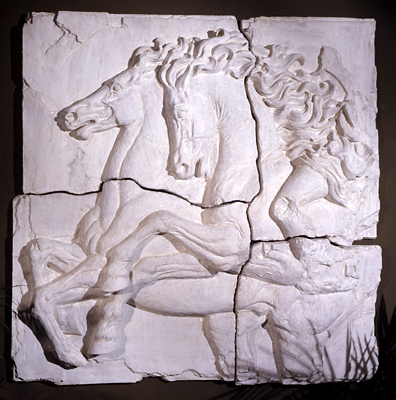Resistances of Force

11.18.11 TME
return to
Educated Equestrian
return to
Educated Equestrian

"The beginner punishes the horse with temper and emphasis, in the opinion that the horse is obstinate and opposing his will. So did even I, and for a long time I did not even consider the horse could not know anything about my will. The experienced rider rebukes him patiently only because of insufficient responses to the aids. The difference is very important, as the riders' mind in the later event is far less put to the test." Ehrengranat
A resistance of force has a different cause than the resistance of weight, and may be remedied in a different manner. It is described by Kerbrech as originating from contractions of the jaw, and may or may not be intentional on the horse’s part. A clenched jaw can be a signal to the handler of tension in the horse’s body, and can be an indicator of mental stress or anxiety, a defensive gesture on the horse’s part, or simply an undesirable habit the horse has unwittingly developed.
A horse’s physical and mental states are inseparably entwined. The biting, chewing, licking swallowing process of grazing produces the most ideal state of calm and relaxation in the horse’s mind and body. While it's not possible or desirable to allow the horse a non-stop supply of food while we're handling him, it is possible to simulate this same process—and its effects—intentionally and calculatedly. One can instigate this process by hand, and later when mounted, by hand via the rein and snaffle bit. The hand on the rein serves not only to transmit requests to the horse; its other primary function is to receive information from the horse, monitor the state of the jaw, and thereby, his mental and emotional state.
Like any other request we introduce, we need to prepare the horse to understand our meaningful request for jaw relaxation. It begins with simple play, preferably instigated by the horse. Once confident of his safety, the horse will exhibit his curiosity, and will delight in oral exploration. He can use his thick lips to grab and carry, or to gently feel and lightly caress or grasp. His whiskers and nostrils serve to add tactile and olfactory information to his exploration. His tongue can taste you or the object you present, and his teeth can clamp down on your fingers, if you are inattentive.
It is for the handler to set the boundaries, and teach the horse which actions are acceptable, and which are undesirable. His mouth serves much as a toddler’s hand and mouth; he will initially experiment with his human subject, to learn more about it, without any clue of our ideas of “right” and “wrong”. Biting is a common concern people have, one of the “wrongs” a horse will need to learn about, but biting is only one of several actions a horse can execute with his mouth. This is important to understand, because we don’t want to lose the multiple valuable facets of this exercise, out of fear of this one undesirable one. An attentive handler can usually avoid damage, if she is careful to intervene early, when play begins to get “rough”. Removing the object of interest, whether it be your hand or some other article, and turning away is usually enough to indicate to the horse their action was unacceptable. Out of a desire to keep the object of interest at their disposal, they will generally adapt a more acceptable degree of play.
Once the horse understands our desire and request for a relaxed jaw, and has the opportunity to enjoy the benefits of the jaw flexion, you will find he readily and happily participates in the process. A horse who is well-introduced to this simulation finds the bit a delight, a comforting pacifier, and will eventually develop the understanding that he doesn't need to wait for the rider’s hand to request a jaw flexion. He may use the bit on his own accord, to comfort himself when tension or stress approaches. A horse who has reached this level of understanding is an absolute delight to ride. He is compliant and content, looks forward to indications of the hand, and will recover from startles and frights quickly and independently, by instigating jaw flexions on his own. Bridling is not a problem, as he is eager to have the bit, and basic grooming or oral vet care can be administered more easily, because the horse is comfortable being touched on the mouth and face.
A resistance of force has a different cause than the resistance of weight, and may be remedied in a different manner. It is described by Kerbrech as originating from contractions of the jaw, and may or may not be intentional on the horse’s part. A clenched jaw can be a signal to the handler of tension in the horse’s body, and can be an indicator of mental stress or anxiety, a defensive gesture on the horse’s part, or simply an undesirable habit the horse has unwittingly developed.
A horse’s physical and mental states are inseparably entwined. The biting, chewing, licking swallowing process of grazing produces the most ideal state of calm and relaxation in the horse’s mind and body. While it's not possible or desirable to allow the horse a non-stop supply of food while we're handling him, it is possible to simulate this same process—and its effects—intentionally and calculatedly. One can instigate this process by hand, and later when mounted, by hand via the rein and snaffle bit. The hand on the rein serves not only to transmit requests to the horse; its other primary function is to receive information from the horse, monitor the state of the jaw, and thereby, his mental and emotional state.
Like any other request we introduce, we need to prepare the horse to understand our meaningful request for jaw relaxation. It begins with simple play, preferably instigated by the horse. Once confident of his safety, the horse will exhibit his curiosity, and will delight in oral exploration. He can use his thick lips to grab and carry, or to gently feel and lightly caress or grasp. His whiskers and nostrils serve to add tactile and olfactory information to his exploration. His tongue can taste you or the object you present, and his teeth can clamp down on your fingers, if you are inattentive.
It is for the handler to set the boundaries, and teach the horse which actions are acceptable, and which are undesirable. His mouth serves much as a toddler’s hand and mouth; he will initially experiment with his human subject, to learn more about it, without any clue of our ideas of “right” and “wrong”. Biting is a common concern people have, one of the “wrongs” a horse will need to learn about, but biting is only one of several actions a horse can execute with his mouth. This is important to understand, because we don’t want to lose the multiple valuable facets of this exercise, out of fear of this one undesirable one. An attentive handler can usually avoid damage, if she is careful to intervene early, when play begins to get “rough”. Removing the object of interest, whether it be your hand or some other article, and turning away is usually enough to indicate to the horse their action was unacceptable. Out of a desire to keep the object of interest at their disposal, they will generally adapt a more acceptable degree of play.
Once the horse understands our desire and request for a relaxed jaw, and has the opportunity to enjoy the benefits of the jaw flexion, you will find he readily and happily participates in the process. A horse who is well-introduced to this simulation finds the bit a delight, a comforting pacifier, and will eventually develop the understanding that he doesn't need to wait for the rider’s hand to request a jaw flexion. He may use the bit on his own accord, to comfort himself when tension or stress approaches. A horse who has reached this level of understanding is an absolute delight to ride. He is compliant and content, looks forward to indications of the hand, and will recover from startles and frights quickly and independently, by instigating jaw flexions on his own. Bridling is not a problem, as he is eager to have the bit, and basic grooming or oral vet care can be administered more easily, because the horse is comfortable being touched on the mouth and face.
The benefit of teaching the horse this lesson is two-fold: not only does it save our fingers and backsides from uncomfortable invasions, but it also introduces the message, “Locking the jaw (biting) is not ok. You must maintain a soft jaw, to continue our interaction together.” This is one of the cornerstones of the horse’s education, and the gives the rider the ability to address all varieties of resistances of force that may surface later, throughout the training process.
The horse will, from time to time, employ not only a basic resistance of force, or a basic resistance of weight, but combinations of each, concurrently or consecutively. Riders need to monitor and address these resistances, for training, for their artistic skill, to progress. Without horsemen and women with an understanding of resistances, the only saddle horses who will remain are the outlaws and the docile, and the only riders who will continue to practice are the daredevils, thrill seekers who are undisturbed by their horse’s refusals. An understanding of resistances can turn a cowboy into a horseman.